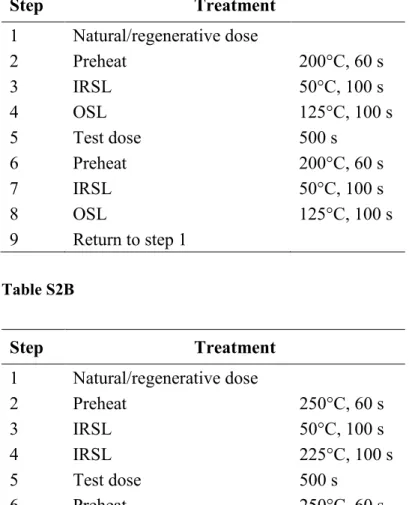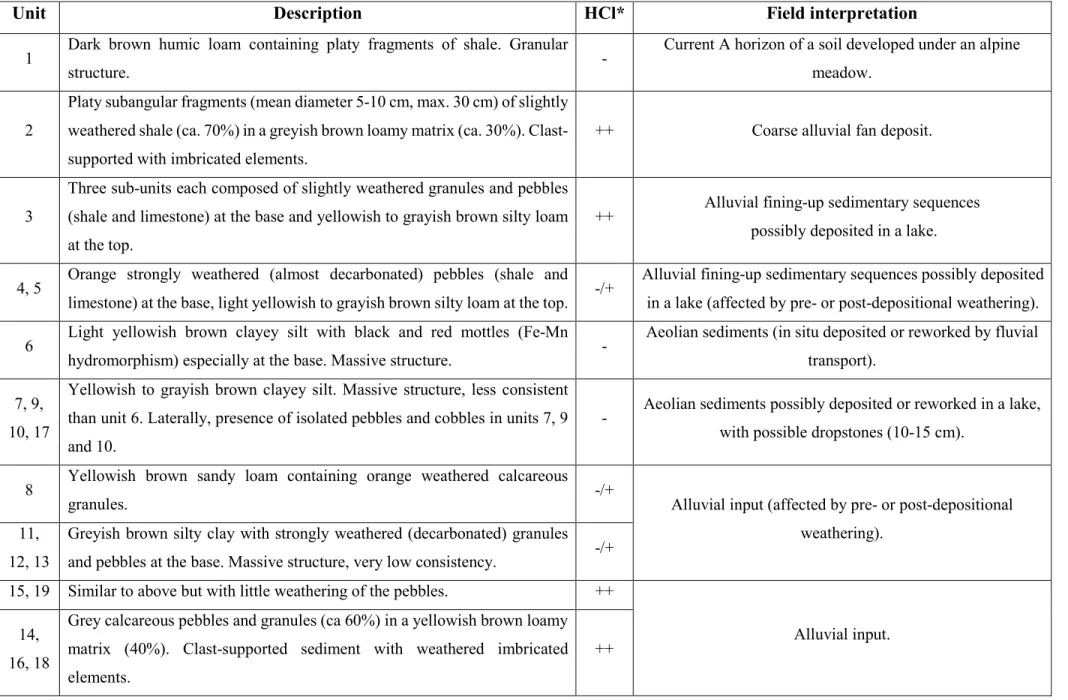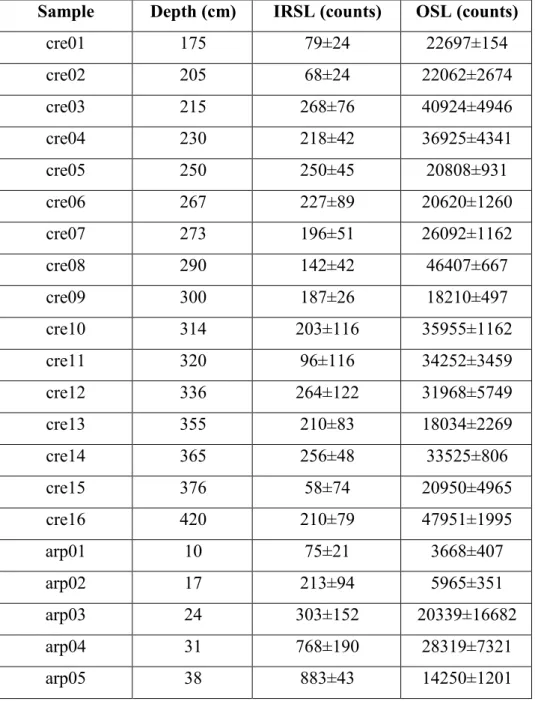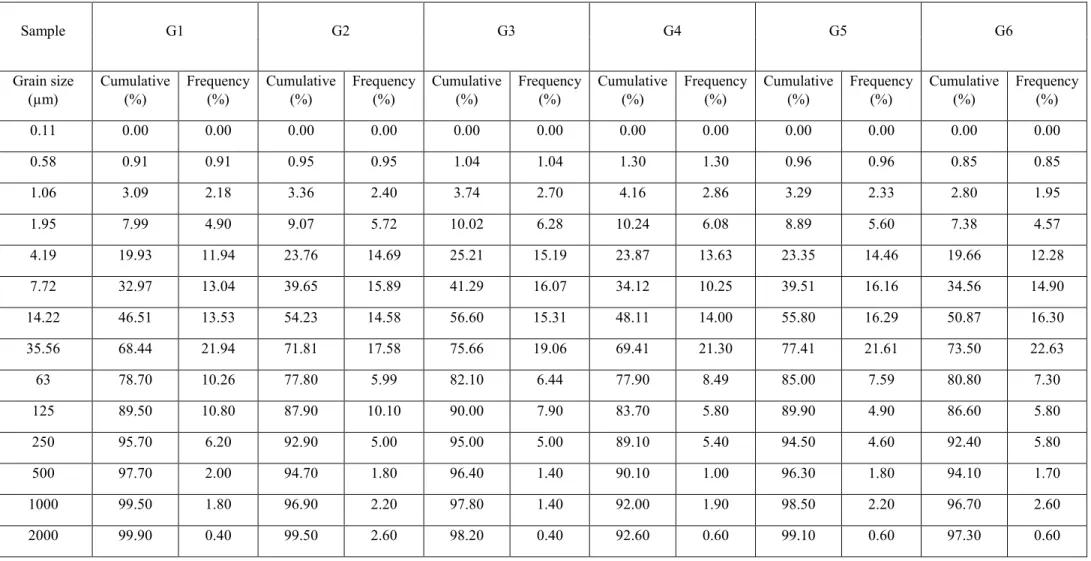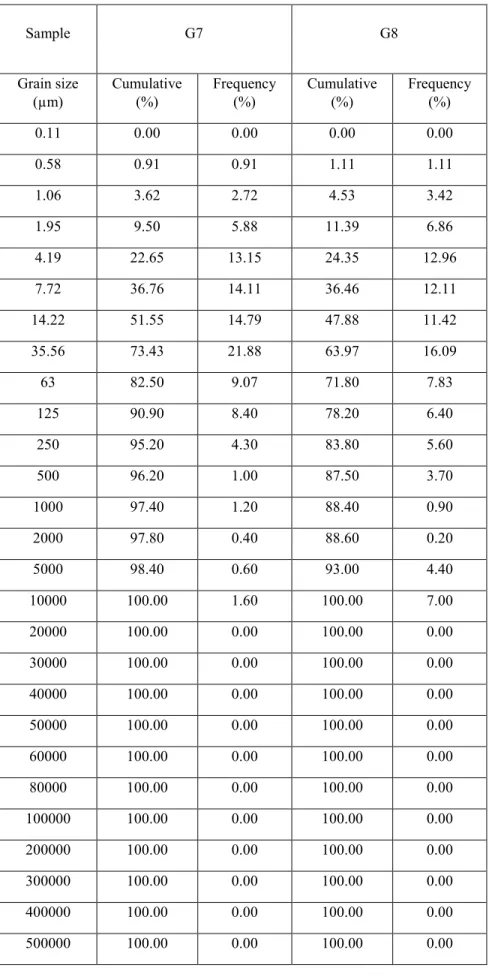Serra, E., Valla, P. G., Gribenski, N., Guedes Magrani, F., Carcaillet, J., Delaloye, R., Grobety, B. & Braillard, L.:
Geomorphic response to the Lateglacial–Holocene transition in high Alpine regions (Sanetsch Pass, Swiss Alps).
2020. Boreas
https://doi.org/10.1111/bor.12480
. ISSN 0300-9483
Supporting information
Table S1. Samples locations, corresponding geomorphic units and conducted analyses.
Sample Name
Location WGS84
(°N/°E)
Altitude
(m a.s.l.)
Geomorphic unit
Analysis
G1 - G6
46.34091/ 7.29049
2100
Alluvial fan (CRE)
Grain-size
G7, G8
46.33703/ 7.31810
2712
High-elevation platform (ARP)
Grain-size
M1 - M3
46.34091/ 7.29049
2100
Alluvial fan (CRE)
Micromorphology
L1, L2; S1, S2
46.33715/ 7.31815;
46.33380/ 7.30790
2712;
2650
Bedrock
(limestone; shale)
Petrographic thin section
CRE01 - CRE16 46.34091/ 7.29049
2100
Alluvial fan (CRE)
XRD and Geochemistry
ARP01, ARP03 46.33703/ 7.31810
2712
High-elevation platform (ARP)
XRD and Geochemistry
L1, L2; S1, S2
46.33715/ 7.31815;
46.33380/ 7.30790
2712;
2650
Bedrock
(limestone; shale)
XRD
cre01 - cre16
46.34091/ 7.29049
2100
Alluvial fan (CRE)
Portable OSL
arp01 - arp05
46.33703/ 7.31810
2712
High-elevation platform (ARP)
Portable OSL
CRE01 - CRE04 46.34091/ 7.29049
2100
Alluvial fan (CRE)
OSL burial dating
ARP01 - ARP03 46.33703/ 7.31810
2712
High-elevation platform (ARP)
OSL burial dating
SAN01
46.35111/ 7.28751
2055
Rockfall deposit (SAN)
10Be exposure dating
SAN02
46.35117/ 7.28900
2056
Rockfall deposit (SAN)
10Be exposure dating
SAN03
46.35137/ 7.28874
2054
Rockfall deposit (SAN)
10Be exposure dating
Table S2. Luminescence protocols. A. Post-IR OSL protocol, after Murray & Wintle (2000),
applied on quartz separates from CRE and ARP sample (except for sample ARP03, which did not
provide enough material for quartz purification
).B. Post-IR IRSL protocol, after Buylaert et al.
(2009), applied on polymineral ARP samples. No post-IR IRSL measurements were performed on
CRE samples due to the absence of feldspar IRSL signal.
Table S2A
Table S2BStep
Treatment
1
Natural/regenerative dose
2
Preheat
250°C, 60 s
3
IRSL
50°C, 100 s
4
IRSL
225°C, 100 s
5
Test dose
500 s
6
Preheat
250°C, 60 s
7
IRSL
50°C, 100 s
8
IRSL
225°C, 100 s
9
IRSL
290°C, 40 s
10
Return to step 1
Step
Treatment
1
Natural/regenerative dose
2
Preheat
200°C, 60 s
3
IRSL
50°C, 100 s
4
OSL
125°C, 100 s
5
Test dose
500 s
6
Preheat
200°C, 60 s
7
IRSL
50°C, 100 s
8
OSL
125°C, 100 s
9
Return to step 1
Table S3. Stratigraphic description and field interpretation of the sedimentological units forming the ARP high-elevation platform
deposit. The thickness of the units is given in Fig. 4. *Reaction to HCl on the field: no (-), little (-/+), strong (+), very strong (++)
reaction.
Unit Description HCl* Field interpretation
1
Angular platy fragments of grey siliceous limestones (60%) in a greyish brown silty matrix (40%). Clast-supported, no preferred orientation of elements. Well-developed forms of sorted polygonal patterned grounds on the surface.
- In situ cryoclasts bedrock derived,
reworked by frost and thaw processes. 2 Light yellowish brown silt containing few limestone angular fragments.
Table S4. Stratigraphic description and field interpretation of the sedimentological units forming the upper 4.5 m of the CRE alluvial
fan. The thickness of the units is given in Fig. 5. *Reaction to HCl on the field: no (-), little (-/+), strong (+), very strong (++) reaction.
Unit
Description
HCl*
Field interpretation
1 Dark brown humic loam containing platy fragments of shale. Granular
structure. -
Current A horizon of a soil developed under an alpine meadow.
2
Platy subangular fragments (mean diameter 5-10 cm, max. 30 cm) of slightly weathered shale (ca. 70%) in a greyish brown loamy matrix (ca. 30%). Clast-supported with imbricated elements.
++ Coarse alluvial fan deposit.
3
Three sub-units each composed of slightly weathered granules and pebbles (shale and limestone) at the base and yellowish to grayish brown silty loam at the top.
++ Alluvial fining-up sedimentary sequences possibly deposited in a lake. 4, 5 Orange strongly weathered (almost decarbonated) pebbles (shale and
limestone) at the base, light yellowish to grayish brown silty loam at the top. -/+
Alluvial fining-up sedimentary sequences possibly deposited in a lake (affected by pre- or post-depositional weathering). 6 Light yellowish brown clayey silt with black and red mottles (Fe-Mn
hydromorphism) especially at the base. Massive structure. -
Aeolian sediments (in situ deposited or reworked by fluvial transport).
7, 9, 10, 17
Yellowish to grayish brown clayey silt. Massive structure, less consistent than unit 6. Laterally, presence of isolated pebbles and cobbles in units 7, 9 and 10.
- Aeolian sediments possibly deposited or reworked in a lake, with possible dropstones (10-15 cm).
8 Yellowish brown sandy loam containing orange weathered calcareous
granules. -/+ Alluvial input (affected by pre- or post-depositional
weathering). 11,
12, 13
Greyish brown silty clay with strongly weathered (decarbonated) granules and pebbles at the base. Massive structure, very low consistency. -/+ 15, 19 Similar to above but with little weathering of the pebbles. ++
Alluvial input. 14,
16, 18
Grey calcareous pebbles and granules (ca 60%) in a yellowish brown loamy matrix (40%). Clast-supported sediment with weathered imbricated elements.
Table S5. Luminescence signal intensities measured for CRE and ARP sites using the
SUERC portable OSL reader (Sanderson & Murphy 2010), and following the measurement sequence of Muñoz-Salinas et al. (2014). IRSL counts are the total photon counts obtained after the first 30 s of IRSL
stimulation. OSL counts are the total photon counts obtained after the 60 s of OSL stimulation.
The counts and respective errors were obtained by averaging between two replicate
measurements of each bulk sediment sample.
Dim IRSL counts were measured along the CRE
section, due to the low-feldspar content in the analysed sediments. For this reason, only the
OSL signal intensity profile is represented in Fig. 10.
Sample
Depth (cm)
IRSL (counts)
OSL (counts)
cre01
175
79±24
22697±154
cre02
205
68±24
22062±2674
cre03
215
268±76
40924±4946
cre04
230
218±42
36925±4341
cre05
250
250±45
20808±931
cre06
267
227±89
20620±1260
cre07
273
196±51
26092±1162
cre08
290
142±42
46407±667
cre09
300
187±26
18210±497
cre10
314
203±116
35955±1162
cre11
320
96±116
34252±3459
cre12
336
264±122
31968±5749
cre13
355
210±83
18034±2269
cre14
365
256±48
33525±806
cre15
376
58±74
20950±4965
cre16
420
210±79
47951±1995
arp01
10
75±21
3668±407
arp02
17
213±94
5965±351
arp03
24
303±152
20339±16682
arp04
31
768±190
28319±7321
arp05
38
883±43
14250±1201
Table S6. Grain-size distributions of CRE (G1-G6; S6A) and ARP (G7 and G8; S6B) samples. Individual cumulative and frequency percentages of the different
grain sizes are reported. Details about
grain-size distribution measurements
are given in the main text.Table S6A. Grain-size distributions of CRE samples.
Sample G1 G2 G3 G4 G5 G6
Grain size
(µm) Cumulative (%) Frequency (%) Cumulative (%) Frequency (%) Cumulative (%) Frequency (%) Cumulative (%) Frequency (%) Cumulative (%) Frequency (%) Cumulative (%) Frequency (%)
0.11 0.00 0.00 0.00 0.00 0.00 0.00 0.00 0.00 0.00 0.00 0.00 0.00 0.58 0.91 0.91 0.95 0.95 1.04 1.04 1.30 1.30 0.96 0.96 0.85 0.85 1.06 3.09 2.18 3.36 2.40 3.74 2.70 4.16 2.86 3.29 2.33 2.80 1.95 1.95 7.99 4.90 9.07 5.72 10.02 6.28 10.24 6.08 8.89 5.60 7.38 4.57 4.19 19.93 11.94 23.76 14.69 25.21 15.19 23.87 13.63 23.35 14.46 19.66 12.28 7.72 32.97 13.04 39.65 15.89 41.29 16.07 34.12 10.25 39.51 16.16 34.56 14.90 14.22 46.51 13.53 54.23 14.58 56.60 15.31 48.11 14.00 55.80 16.29 50.87 16.30 35.56 68.44 21.94 71.81 17.58 75.66 19.06 69.41 21.30 77.41 21.61 73.50 22.63 63 78.70 10.26 77.80 5.99 82.10 6.44 77.90 8.49 85.00 7.59 80.80 7.30 125 89.50 10.80 87.90 10.10 90.00 7.90 83.70 5.80 89.90 4.90 86.60 5.80 250 95.70 6.20 92.90 5.00 95.00 5.00 89.10 5.40 94.50 4.60 92.40 5.80 500 97.70 2.00 94.70 1.80 96.40 1.40 90.10 1.00 96.30 1.80 94.10 1.70 1000 99.50 1.80 96.90 2.20 97.80 1.40 92.00 1.90 98.50 2.20 96.70 2.60 2000 99.90 0.40 99.50 2.60 98.20 0.40 92.60 0.60 99.10 0.60 97.30 0.60
5000 100.00 0.10 99.60 0.10 99.10 0.90 96.30 3.70 99.80 0.70 98.50 1.20 10000 100.00 0.00 100.00 0.40 100.00 0.90 100.00 3.70 100.00 0.20 100.00 1.50 20000 100.00 0.00 100.00 0.00 100.00 0.00 100.00 0.00 100.00 0.00 100.00 0.00 30000 100.00 0.00 100.00 0.00 100.00 0.00 100.00 0.00 100.00 0.00 100.00 0.00 40000 100.00 0.00 100.00 0.00 100.00 0.00 100.00 0.00 100.00 0.00 100.00 0.00 50000 100.00 0.00 100.00 0.00 100.00 0.00 100.00 0.00 100.00 0.00 100.00 0.00 60000 100.00 0.00 100.00 0.00 100.00 0.00 100.00 0.00 100.00 0.00 100.00 0.00 80000 100.00 0.00 100.00 0.00 100.00 0.00 100.00 0.00 100.00 0.00 100.00 0.00 100000 100.00 0.00 100.00 0.00 100.00 0.00 100.00 0.00 100.00 0.00 100.00 0.00 200000 100.00 0.00 100.00 0.00 100.00 0.00 100.00 0.00 100.00 0.00 100.00 0.00 300000 100.00 0.00 100.00 0.00 100.00 0.00 100.00 0.00 100.00 0.00 100.00 0.00 400000 100.00 0.00 100.00 0.00 100.00 0.00 100.00 0.00 100.00 0.00 100.00 0.00 500000 100.00 0.00 100.00 0.00 100.00 0.00 100.00 0.00 100.00 0.00 100.00 0.00
Table S6B. Grain-size distributions of ARP samples.
Sample G7 G8
Grain size
(µm) Cumulative (%) Frequency (%) Cumulative (%) Frequency (%)
0.11 0.00 0.00 0.00 0.00 0.58 0.91 0.91 1.11 1.11 1.06 3.62 2.72 4.53 3.42 1.95 9.50 5.88 11.39 6.86 4.19 22.65 13.15 24.35 12.96 7.72 36.76 14.11 36.46 12.11 14.22 51.55 14.79 47.88 11.42 35.56 73.43 21.88 63.97 16.09 63 82.50 9.07 71.80 7.83 125 90.90 8.40 78.20 6.40 250 95.20 4.30 83.80 5.60 500 96.20 1.00 87.50 3.70 1000 97.40 1.20 88.40 0.90 2000 97.80 0.40 88.60 0.20 5000 98.40 0.60 93.00 4.40 10000 100.00 1.60 100.00 7.00 20000 100.00 0.00 100.00 0.00 30000 100.00 0.00 100.00 0.00 40000 100.00 0.00 100.00 0.00 50000 100.00 0.00 100.00 0.00 60000 100.00 0.00 100.00 0.00 80000 100.00 0.00 100.00 0.00 100000 100.00 0.00 100.00 0.00 200000 100.00 0.00 100.00 0.00 300000 100.00 0.00 100.00 0.00 400000 100.00 0.00 100.00 0.00 500000 100.00 0.00 100.00 0.00
Table S7. XRD bulk mineralogical compositions of CRE (CRE01-CRE16), ARP (ARP01 andARP03) and
bedrock (L1-L2: siliceous limestone, S1-S2: calcareous shale) samples. Cumulative mineral percentages are reported. Details about
XRD analyses
are given in the main text.Sample Quartz (%) Micas (%) Chlorite (%) Albite (%) Calcite (%) Dolomite (%)
CRE01 36.9 42.5 10.6 0.0 10.0 0.0 CRE02 39.2 51.5 9.3 0.0 0.0 0.0 CRE03 50.0 36.0 14.0 0.0 0.0 0.0 CRE04 42.7 22.5 9.9 11.1 13.9 0.0 CRE05 54.4 41.8 3.8 0.0 0.0 0.0 CRE06 46.5 41.3 12.2 0.0 0.0 0.0 CRE07 46.7 40.5 12.8 0.0 0.0 0.0 CRE08 51.4 40.6 8.0 0.0 0.0 0.0 CRE09 41.1 50.8 8.1 0.0 0.0 0.0 CRE10 52.9 39.5 7.6 0.0 0.0 0.0 CRE11 54.0 44.9 1.1 0.0 0.0 0.0 CRE12 43.3 36.1 8.4 0.0 12.3 0.0 CRE13 41.6 38.2 7.9 0.0 12.3 0.0 CRE14 32.4 22.9 6.3 0.0 38.5 0.0 CRE15 41.8 42.9 9.8 0.0 5.5 0.0 CRE16 35.6 30.3 7.4 0.0 26.6 0.0 ARP01 69.6 18.9 7.6 3.9 0.0 0.0 ARP03 66.7 18.2 8.0 7.1 0.0 0.0 L1 25.6 5.6 0.0 0.0 63.7 5.2 L2 32.7 3.0 0.0 0.0 64.3 0.0 S1 23.7 15.5 0.8 0.0 55.1 4.9 S2 22.5 7.0 4.0 0.0 65.9 0.9

